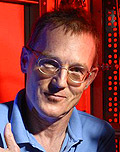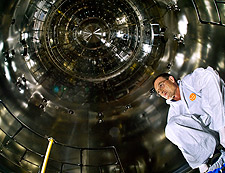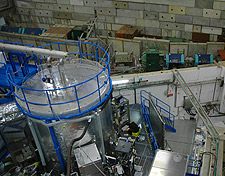CERN, the acclaimed nuclear research laboratory near Geneva, Switzerland, is best known for the Large Hadron Collider, an enormous particle accelerator designed to help scientists understand the basic physical principles of the universe. But there are other important experiments taking place at CERN, including research designed to help resolve one of the biggest uncertainties of climate change — how clouds form and what role they play in regulating Earth’s temperature.

Leading that study is British particle physicist Jasper Kirkby, who heads a team of top atmospheric scientists from 15 European and U.S. institutions on a three-year-old project, fittingly called “CLOUD,” or Cosmics Leaving Outdoor Droplets. The experiment takes place in a vast warehouse at CERN, the European Organization for Nuclear Research. There, scientists shoot tiny streams of water, acid, and vapors into a super-clean stainless steel chamber big enough to fit about two minivans inside. They want to know the recipe for cloud formation, a phenomenon that is not fully understood.
They also hope to understand how clouds are affected by cosmic rays, the streams of charged particles from outer space that continually hit the Earth. Some scientists and climate-change skeptics have suggested that a possible reduction in cosmic rays bombarding the Earth in recent decades has led to the formation of fewer clouds, which would increase the amount of the sun’s energy striking the planet and thus cause recent warming. But Kirkby says there is no firm proof for that theory, and he is hopeful that his team’s research will shed light on the subject.
In an interview at CERN with Yale Environment 360 contributor Rae Ellen Bichell, Kirkby talks about cosmic rays, discusses the pitfalls of geoengineering the planet by trying to mimic the formation of clouds, and explains why his experiments in a sterile steel box could help clear up uncertainties about climate change. “We’ve got to reduce that uncertainty if we’re to really sharpen our understanding for future climate projections,” says Kirkby.
Yale Environment 360: This is a big stainless steel metal bin. What is going on inside?
Jasper Kirkby: The metal bin is a very, very high-tech metal bin. In fact, it’s probably the cleanest garbage can in the world. I think we have built a large chamber that has such low contamination levels that we can do these experiments now for the first time.
e360: The point of this experiment, which has involved thousands of experimental runs over the course of the past three years, is to figure out how clouds are formed in the air?
Kirkby: Yes, we’re trying to understand and measure the basic physicochemical processes that lead to the formation of clouds.
All cloud droplets form on an aerosol particle, which is known as a cloud condensation nucleus. Without them, there would be no clouds. They’re ubiquitous in the atmosphere, but we actually don’t know well how they form.
There are two sources of these aerosol particles. Half of them are coming from particles made on the Earth’s surface, namely sea spray, dust from deserts, or biomass burning. But the other half are coming from a very poorly understood process which involves the condensation of very, very minute amounts of vapors in the atmosphere, which condense to form tiny molecular clusters, which then may grow further and eventually become big enough to seed cloud droplets.
It turns out that roughly half of the seeds of cloud droplets are coming from these processes, but the processes are very poorly understood. In particular, we don’t even understand all the vapors that are involved in the formation. And these vapors are present in the atmosphere at extremely low levels — typically at the level of one in a million million molecules. And that’s why doing the CLOUD experiment is very tough — it means that you have to suppress any contaminant vapors at the level of one in a million million molecules. It’s right at the limit of technology, but I think we’ve gotten there with CLOUD. We can do the experiments.
e360: You’re spraying tiny amounts of chemicals into the chamber, which is outfitted with about 30 instruments measuring the amounts of them, how they are reacting with each other, and how they are blobbing together into these clusters. All of this is simulating a process that happens everywhere in the world: the process that creates clouds.

Kirkby: It’s the process, in this case, that creates the small aerosol particles of which some, but not all, may grow big enough that they will constitute so-called cloud condensation nuclei. It’s the number of aerosol particles — these condensation nuclei — that determines whether there’s a lot of droplets in the cloud, or only a few, or whether they form ice particles or not. These are the critical things that control the formation of the actual microphysical aspects of clouds.
e360: So, if we’re thinking about the experiment in the CLOUD chamber as a giant soup of chemicals…
Kirkby: It’s a soup. We’re cooking it with cosmic rays and continuously tasting the soup as time goes on to see how it tastes over the period of several hours. We’re tasting it with all these instruments that are surrounding the chamber — they’re each sipping a little bit of the soup.
e360: You were saying that aerosols and clouds are the biggest uncertainty right now in our knowledge of mankind’s influence on climate change.
Kirkby: The big warming contribution of mankind is greenhouse gases. At the same time, mankind has been increasing aerosol particle production by emitting various gases into the atmosphere, and these have been cooling the planet. But we don’t know how much they’ve been cooling the planet, because we really don’t understand the fundamental science behind how these vapors turn into particles and then grow into the cloud condensation nuclei. So CLOUD will help reduce that uncertainty and really sharpen the scientific basis and understanding of the subject.
“CLOUD will help clear up to what extent there is a natural contribution to current warming.”
Now, the other area where CLOUD will reduce a very big question mark in current climate change is to what extent there can be a natural contribution to the current warming. The current understanding is that natural warming is very, very small. There’s a short-term contribution from volcanoes, which only lasts a few years. There’s also thought to be a small brightening of the sun over the course of the twentieth century. But apart from that, there’s thought to be nothing else going on — natural contribution — to climate change. On the other hand, if you look at earlier times, you do see changes in the climate that are comparable to the warming that is going on now. But we don’t know what the mechanism is. So at the very least this is a question mark. And at the very most, there could be a contribution that is just unaccounted for at the moment. Whatever it is, we don’t know what the answer is. And we have to settle it before we can really with certainty say we understand what’s going on now.
e360: And what does settling it require?
Kirkby: It requires a lot of observations. I was at an international conference on aerosol in September and I made a comment that we’re getting to the stage with CLOUD where we will understand the processes extremely well, but we still won’t be able to reduce the errors because we don’t have good enough atmospheric observations of what the concentrations of these vapors are in the atmosphere versus altitude. So, there has to be a combined approach where the lab experiments like CLOUD improve the scientific understanding, but at the same time the observational measurements sharpen the knowledge of what’s in the atmosphere. We’ll take care of the laboratory side, I believe, but other people have to also take care of the observations in the atmosphere.
e360: Why are clouds important?
Kirkby: Clouds have two effects. One is that they reflect sunlight. If you’re sunbathing and a cloud goes overhead, it gets colder. That’s because the sun is being reflected. Less warmth is reaching you. By the same token, you know that if it’s a starlit night, it’s much cooler — colder than a cloudy night.

Clouds on average have a net cooling effect of roughly 20 to 30 watts per square meter. It’s quite a large total effect of clouds. And using the same numbers, all of mankind’s activities are thought to have added 1.5 watts per square meter to the heat flux at ground level. So, you can see instantly that you really have to understand possible changes in clouds — to a few percent of precision — if you want to eliminate those as some contributor to climate change.
e360: If we’re talking about what mankind is doing to the climate, we have to talk about geoengineering. One idea is to shoot saltwater into the sky, with the idea that adding salt particles, which act as aerosols, will make more clouds over the ocean, which will then deflect sunlight from warming the Earth. It sounds like the actual scientific basis for this idea is pretty shaky.
Kirkby: The simple fact is, aerosols don’t live that long in the atmosphere. If you put them in the troposphere — the bottom eight or 10 kilometers of the atmosphere — then they’re out about a week later. If you do that, and you put them into the low atmosphere where the clouds are, you essentially commit yourself to doing that for perpetuity.
“If you eject aerosols into the atmosphere, you essentially commit yourself to doing that for perpetuity.”
If you suddenly decide one week that you’re going to cut off all the funding for this fleet of ships that’s throwing salt into the air, one week later you’ll suddenly shock the climate system with a huge change of radiative forcing and goodness knows what that would do to the system. So it’s not something you embark on trivially. There are huge numbers of questions. But from a scientific viewpoint, I would say it’s worth a good experimental test.
Eventually it’s up to funding agencies and society to decide whether or not that makes any sense at all. But we need the scientific information, and we don’t have it at the moment.
e360: Why should policymakers look forward to seeing the results of the CLOUD experiment?
Kirkby: What we’re talking about here is, “How do the results of CLOUD help the understanding of climate, and therefore help policymakers who are concerned with changes in climate?” Well, the primary goal for CLOUD is to understand the effect of cosmic rays on the formation of these so-called seeds for clouds. Now, in the process of doing that, we actually have to study all the seed-making processes at a very fundamental level.
By fundamental I mean we have to understand what the gases are, the vapors, that are responsible for forming these little particles, and secondly we have to understand exactly how quickly they react with each other and how they form the aerosol particles which then, when they grow large enough, constitute the seeds for cloud droplets. And this process is responsible for half the cloud droplets in the atmosphere.
It’s a very, very important process, but it’s very poorly understood. So, the place where I would say policymakers should be very interested in the CLOUD results, we’re going to provide quantitative data that will allow models to be based on true physical processes rather than estimates.
“We can’t settle it by energetic debate. We have to settle it by experimental measurements.”
Now, as well as the sort of large climatic effects, I’d say policymakers are also very concerned with local climatic effects, and these are driven, in the case of aerosols and clouds, by local pollution — by production of sulfur dioxide from coal-fired power plants and so on. But that’s not enough. What we’re finding with CLOUD is that there are other vapors that are important.
We’ve monitored and we’ve known about sulfur dioxide and acid rain and formation of aerosol particles from sulfur dioxide for decades. What’s only coming out in the past few years is that there are many other vapors that are necessary to participate with the sulfur dioxide to make these particles.
A huge amount of the pollution that you see over Beijing and many cities is due to local pollution, which is forming little aerosol particles. But the exact vapors that are responsible for that have to be identified so that the local authorities can figure out which ones to control and which ones don’t need such strong controls.
A few years ago, it was thought that none of these vapors participated in the formation of particles, only in some final growth stage, but it looks like they’re participating right from the beginning. And we haven’t monitored these at all. So, there’s a huge gap in our understanding of local pollution. And, on a bigger scale, aerosols that affect the climate long-term — what these vapors are and how effective they are at forming aerosol particles and hence clouds.
e360: How could a better understanding of the effects of cosmic rays on cloud cover inform policies on air pollution and climate change mitigation?
MORE FROM YALE e360
The Effect of Clouds on Climate: A Key Mystery for Researchers

Kirkby: This concerns something called solar climate variability, which is an observation from many different paleoclimatic reconstructions that there seem to be variations in the sun that cause variations in the climate by about the same amount that we’re experiencing at the moment. Those observations are too many to dismiss and to explain away as mere coincidence. There’s something going on that we don’t understand. So, at the moment there’s a question mark — do we understand the natural causes of climate change? And the answer is, we understand a little about it, but in total we understand very, very little about it. Until we really understand the natural causes of climate change, we’ll always have a huge question mark as to what our understanding is of current climate change.
e360: Let’s assume that cosmic rays don’t have an effect on clouds. What does that mean?
Kirkby: It will settle a particular question, which to my mind can only be settled by experimental data. There’s a huge amount of opinion one way or another on the blogosphere that says “cosmic rays have no effect on the climate” to “cosmic rays do everything in the climate.” And no matter how passionately people believe this view or that view, we can’t settle it by energetic debate. We have to settle it by experimental measurements. We will settle that question, so there will be a firm scientific basis for answering that question by the end of CLOUD, as opposed to a gazillion opinions…
There have been many observations for solar climate variability, but no established mechanism. Cosmic rays are essentially one of the leading candidates — for me, the leading candidate — but if we find that there’s nothing there, we simply eliminate that as a mechanism. Who knows? We really don’t know at this stage.